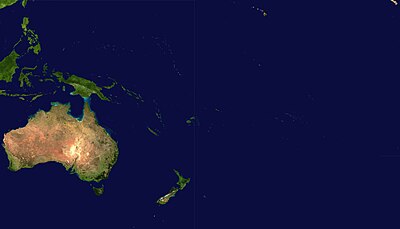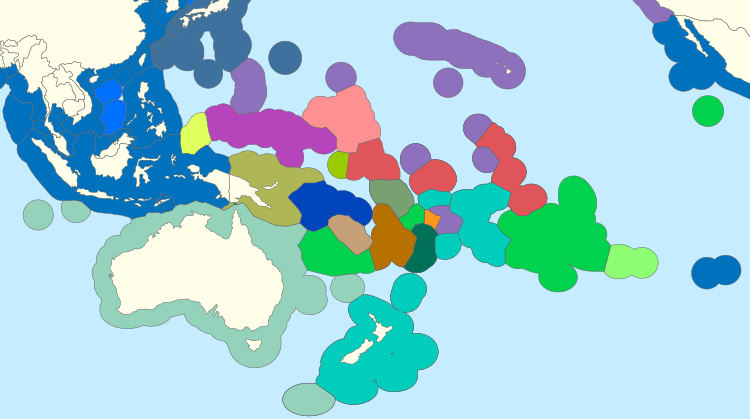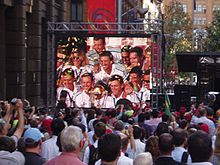This is an old revision of this page, as edited by Pinethicket (talk | contribs) at 08:42, 25 October 2012 (Reverted edits by 84.123.39.175 (talk) to last version by Widr). The present address (URL) is a permanent link to this revision, which may differ significantly from the current revision.
Revision as of 08:42, 25 October 2012 by Pinethicket (talk | contribs) (Reverted edits by 84.123.39.175 (talk) to last version by Widr)(diff) ← Previous revision | Latest revision (diff) | Newer revision → (diff) "South West Pacific" redirects here. For the World War II theatre, see South West Pacific theatre of World War II. For other uses, see Oceania (disambiguation).

Oceania (/ˌəʊʃɪˈɑːnɪə/ or /ˌəʊsɪˈɑːnɪə/) is a region centered on the islands of the tropical Pacific Ocean. Opinions of what constitutes Oceania range from the coral atolls and volcanic islands of the South Pacific (ethnologically divided into the subregions of Melanesia, Micronesia, and Polynesia) to the entire insular region between Asia and the Americas, including Australasia and the Malay Archipelago. The term is sometimes used more specifically to denote a continent comprising Australia and proximate islands, or biogeographically as a synonym for either the Australasian ecozone (Wallacea and Australasia) or the Pacific ecozone (Melanesia, Polynesia, and Micronesia apart either from New Zealand or from mainland New Guinea).
Etymology
The term was coined as Océanie ca. 1812 by geographer Conrad Malte-Brun. The word Océanie is a French language word derived from the Greek word ὠκεανός (ōkeanós), ocean.
Definitions

Oceania
| Demonym | Oceanic; Oceanian |
|---|---|
| Area | 8,536,716 km (3,296,044 sq mi) |
| Population | 35,670,000 |
| Countries | 14 |
| Dependencies |
25
|
| Languages | 28 Official |
| Time Zones | UTC+8 (Australian Western Standard Time) to UTC-6 (Easter Island) (West to East) |
| Largest Cities | Sydney Melbourne Brisbane Perth Auckland Adelaide |
Physiography
Main article: Geography of OceaniaOceania was originally conceived as the lands of the Pacific Ocean, stretching from the Straits of Malacca to the coast of the Americas. It comprised four regions: Polynesia, Micronesia, Malaysia (now called the Malay Archipelago), and Melanesia (now called Australasia). Included are parts of three geological continents, Eurasia, Australia, and Zealandia, as well the non-continental volcanic islands of the Philippines, Wallacea, and the open Pacific. It extends to Sumatra in the west, the Bonin Islands in the northwest, the Hawaiian Islands in the northeast, Rapa Nui and Sala y Gómez Island in the east, and Macquarie Island in the south, but excludes Taiwan, the Japanese Archipelago (including the Ryukyu Islands), and Aleutian Islands of the margins of Asia.
The states that occupy Oceania that are not included in geopolitical Oceania are Indonesia, Malaysia (through Malaysian Borneo), Brunei, the Philippines, and East Timor. The islands of the geographic extremes are politically integral parts of Japan (Bonin), the United States (Hawaii), and Chile (Rapa Nui, formerly Easter Island). A smaller geographic definition also exists, which excludes the land on the Sunda Plate, but includes Indonesian New Guinea as part of the Australian continent.
Biogeography
Biogeographically, Oceania is used as a synonym for either the Australasian ecozone (Wallacea and Australasia) or the Pacific ecozone (Melanesia, Polynesia, and Micronesia apart either from New Zealand or from mainland New Guinea).
Ecogeography
Oceania is one of eight terrestrial ecozones, which constitute the major ecological regions of the planet. The Oceania ecozone includes all of Micronesia, Fiji, and all of Polynesia except New Zealand. New Zealand, New Guinea, Melanesia apart from Fiji, and Australia constitute the separate Australasia ecozone. The Malay Archipelago is part of the Indomalaya ecozone. Related to these concepts are Near Oceania, that part of western Island Melanesia which has been inhabited for tens of millennia, and Remote Oceania, which is more recently settled.
Geopolitics

In the geopolitical conception used by the United Nations, International Olympic Committee, and many atlases, Oceania includes Australia and the nations of the Pacific from Papua New Guinea east, but not the Malay Archipelago or Indonesian New Guinea.
Other definitions
- The term is often used to denote a continent comprising Australia and proximate islands.
- New Zealand forms the south-western corner of the Polynesian Triangle. Its indigenous Māori constitute one of the major cultures of Polynesia. It is also, however, considered part of Australasia.
- The widest definition of Oceania includes the entire region between continental Asia and the Americas, thereby including islands in the Pacific Rim such as the Japanese Archipelago, Taiwan, and the Aleutian islands.


Demographics
Main article: Demographics of OceaniaOceania

Wider Geographic Oceania.
Little of the South Pacific is apparent at this scale, though Hawaii is just visible near the eastern horizon.
| Area | 10,975,600 km (4,237,700 sq mi) |
|---|---|
| Population | 378 million (2010) |
| Time Zones | UTC+7 (Western Indonesian Time) to UTC-6 (Easter Island) |
| Largest Cities | Jakarta Manila Sydney Bandung Melbourne Surabaya Medan |

Narrower Geographic Oceania.
Island Melanesia, Micronesia, and Polynesia (apart from New Zealand)
| Area | 183,000 km (71,000 sq mi) |
|---|---|
| Population | 5.2 million (2008) |
| Time Zones | UTC+9 (Palau) to UTC-6 (Easter Island) |
| Largest Cities | Honolulu Nouméa Suva Papeete Honiara |

The demographic table below shows the subregions and countries of geopolitical Oceania. The countries and territories in this table are categorized according to the scheme for geographic subregions used by the United Nations. The information shown follows sources in cross-referenced articles; where sources differ, provisos have been clearly indicated. These territories and regions are subject to various additional categorisations, of course, depending on the source and purpose of each description.
| Name of region, followed by countries and their flags |
Area (km²) |
Population | Population density (per km²) |
Capital | ISO 3166-1 |
|---|---|---|---|---|---|
| Australasia | |||||
| 7,686,850 | 22,028,000 | 2.7 | Canberra | AU | |
| 268,680 | 4,108,037 | 14.5 | Wellington | NZ | |
| External territories of Australia: | |||||
| Ashmore and Cartier Islands | 199 | ||||
| 135 | 1,493 | 3.5 | Flying Fish Cove | CX | |
| 14 | 628 | 45.1 | West Island | CC | |
| Coral Sea Islands | 10 | 4 | |||
| Heard Island and McDonald Islands | 372 | HM | |||
| 35 | 2,114 | 53.3 | Kingston | NF | |
| Melanesia | |||||
| 18,270 | 856,346 | 46.9 | Suva | FJ | |
| 19,060 | 240,390 | 12.6 | Nouméa | NC | |
| 462,840 | 5,172,033 | 11.2 | Port Moresby | PG | |
| 28,450 | 494,786 | 17.4 | Honiara | SB | |
| 12,200 | 240,000 | 19.7 | Port Vila | VU | |
| 14,874 | 1,187,000 | 76.2 | Dili | TL | |
| Micronesia | |||||
| 702 | 135,869 | 193.5 | Palikir | FM | |
| 549 | 160,796 | 292.9 | Hagåtña | GU | |
| 811 | 96,335 | 118.8 | South Tarawa | KI | |
| 181 | 73,630 | 406.8 | Majuro | MH | |
| 21 | 12,329 | 587.1 | Yaren (de facto) | NR | |
| 477 | 77,311 | 162.1 | Saipan | MP | |
| 458 | 19,409 | 42.4 | Melekeok | PW | |
| 2 | 12 | Wake Island | UM | ||
| Polynesia | |||||
| 199 | 68,688 | 345.2 | Pago Pago, Fagatogo | AS | |
| 240 | 20,811 | 86.7 | Avarua | CK | |
| 163.6 | 3,791 | 23.1 | Hanga Roa | CL | |
| 4,167 | 257,847 | 61.9 | Papeete | PF | |
| 16,636 | 1,360,301 | 81.8 | Honolulu | US | |
| 260 | 2,134 | 8.2 | Alofi | NU | |
| 5 | 47 | 10 | Adamstown | PN | |
| 2,944 | 179,000 | 63.2 | Apia | WS | |
| 10 | 1,431 | 143.1 | Nukunonu | TK | |
| 748 | 106,137 | 141.9 | Nukuʻalofa | TO | |
| 26 | 11,146 | 428.7 | Funafuti | TV | |
| 274 | 15,585 | 56.9 | Mata-Utu | WF | |
| Total | 8,536,716 | 35,669,267 | 4.2 | ||
| Total minus mainland Australia | 849,866 | 13,641,267 | 16.1 | ||
 Australia
New
Australia
NewZealand Chatham Hawaii Wake Federated States of Micronesia Palau Papua New Guinea Easter Island French Polynesia Cook Islands New Caledonia Fiji Tuvalu Kiribati Phoenix Line Solomon Islands Tokelau Marshall Islands Nauru Vanuatu Tonga Pitcairn Guam Norfolk Northern Marianas Samoa AS WF Niue Cocos Christmas Ryukyu Islands Izu Bonin Volcano Okinotori shima Minamitori shima Midway Johnston Clipperton Socorro Howland Baker Kingman Palmyra Jarvis Coral Sea Lord Howe Kermadec Bounties Three Kings Antipodes Aucklands Solander Snares Campbell Ashmore & Cartier Macquarie Indonesia Philippines Sarawak BN Sabah Maluku Papua East Timor Paracels Spratlys This template: |
Religion
The predominant religion in Oceania is Christianity. Traditional religions are often animist and prevalent among traditional tribes is the belief in spirits (masalai in Tok Pisin) representing natural forces. In recent Australian and New Zealand censuses, large proportions of the population say they belong to "No religion" (which includes atheism, agnosticism, Secular Humanism, and rationalism). In Tonga, everyday life is heavily influenced by Polynesian traditions and especially by the Christian faith. The Bahá'í House of Worship in Tiapapata, Samoa is one of seven designations administered in the Baha'i faith.
Sport
Pacific Games
The Pacific Games (formerly known as the South Pacific Games) is a multi-sport event, much like the Olympics on a much smaller scale, with participation exclusively from countries around the Pacific. It is held every four years and began in 1963. Australia and New Zealand do not compete at the Pacific Games.
Rugby League
Rugby league is a popular sport throughout Oceania, and is the national sport of Papua New Guinea (the second most populous country in Oceania after Australia) and is very popular in Australia and attracts significant attention across New Zealand and the Pacific Islands.
Australia and New Zealand are two of the most successful sides in the world. Australia has won the Rugby League World Cup a record nine times while New Zealand won their first World Cup in 2008. Australia hosted the second tournament in 1957. Australia and New Zealand jointly hosted it in 1968 and 1977. New Zealand hosted the final for the first time in 1985 – 1988 tournament and Australia hosted the last tournament in 2008.
Rugby Union

Rugby union is one of the region's most prominent sports, and is the national sport of New Zealand, Samoa, Fiji and Tonga. Fiji's sevens team is one of the most successful in the world, as is New Zealand's.
New Zealand and Australia have won the Rugby World Cup a record two times (tied with South Africa who have also won it two times). New Zealand won the inaugural World Cup in 1987. Australia and New Zealand jointly hosted the World Cup in 1987. Australia hosted it in 2003 and New Zealand hosted it in 2011, which they then went on to win.
Cricket

Cricket is a popular summer sport in Australia and New Zealand. Australia had ruled International cricket as the number one team for more than a decade, and have won four Cricket World Cups and have been runner-up for two times, making them the most successful cricket team. New Zealand is also considered a strong competitor in the sport, with the New Zealand Cricket Team, also called the Black Caps, enjoying success in many competitions. Both Australia and New Zealand are Full members of the ICC. Fiji, Vanuatu and Papua New Guinea are some of the Associate/Affiliate members of the ICC from Oceania that are governed by ICC East Asia-Pacific. Beach Cricket, a greatly simplified variant of cricket played on a sand beach, is also a popular recreational sport in Australia.
Cricket is culturally a significant sport for summer in Oceania. The Boxing Day Test is very popular in Australia, conducted every year on 26 December at the Melbourne Cricket Ground, Melbourne.
Australian rules football
Main article: Australian rules football in OceaniaAustralian rules football is the national sport in Nauru and is the most popular football code in Australia. It is also popular in Papua New Guinea.
Association football (soccer)
The Oceania Football Confederation (OFC) is one of six association football confederations under the auspices of FIFA, the international governing body of the sport. The OFC is the only confederation without an automatic qualification to the World Cup Finals. Currently the winner of the OFC qualification tournament must play off against an Asian confederation side to qualify for the World Cup.
Currently, Vanuatu is the only country in Oceania to call football (soccer) its national sport.
Oceania has been represented at four World Cup finals tournaments — Australia in 1974, 2006 and 2010, and New Zealand in 1982 and 2010. In 2006, Australia joined the Asian Football Confederation and qualified for the 2010 World cup as an Asian entrant. New Zealand qualified through the Oceania Confederation, winning its playoff against Bahrain. 2010 was the first time two countries from Oceania had qualified at the same time, albeit through different confederations.
See also
Main article: Outline of Oceania
|
Notes
- Pronunciation: The New Oxford Dictionary of English (1998) ISBN 0-19-861263-X - p.1282 "Oceania /ˌəʊsɪˈɑːnɪə, -ʃɪ-/".
- For a history of the term, see Douglas & Ballard (2008) Foreign bodies: Oceania and the science of race 1750–1940
- "Oceania". 2005. The Columbia Encyclopedia, 6th ed. Columbia University Press.
- ^ "Oceania". Oxford English Dictionary (Online ed.). Oxford University Press. (Subscription or participating institution membership required.)
- Composition of macro geographical (continental) regions, geographical sub-regions, and selected economic and other groupings, United Nations Statistics Division. Revised August 28, 2007. Accessed on line October 11, 2007.
- The Atlas of Canada. Revised Date Modified: August 17, 2004. Accessed on line January 31, 2011.
- ^ "Encarta Mexico "Oceanía"". Mx.encarta.msn.com. Archived from the original on 2009-11-01. Retrieved 2009-04-17.
{{cite web}}: Unknown parameter|deadurl=ignored (|url-status=suggested) (help) - ^ Lewis, Martin W. (1997). The Myth of Continents: a Critique of Metageography. Berkeley: University of California Press. p. 32. ISBN 0-520-20742-4, ISBN 0-520-20743-2.
Interestingly enough, the answer conformed almost precisely to the conventional list: North America, South America, Europe, Asia, Oceania (Australia plus New Zealand), Africa, and Antarctica.
{{cite book}}: Unknown parameter|coauthors=ignored (|author=suggested) (help) - ^ Udvardy. 1975. A classification of the biogeographical provinces of the world
- ^ Steadman. 2006. Extinction & biogeography of tropical Pacific birds
- D'Urville, Jules-Sébastien-César Dumont. "On the Islands of the Great Ocean". The Journal of Pacific History. 38 (2). Taylor & Francis, Ltd.
{{cite journal}}: Unknown parameter|coauthors=ignored (|author=suggested) (help) - MacKay (1864, 1885) Elements of Modern Geography, p 283
- Douglas & Ballard (2008) Foreign bodies: Oceania and the science of race 1750–1940
- Ben Finney, The Other One-Third of the Globe, Journal of World History, Vol. 5, No. 2, Fall, 1994.
- ^ "United Nations Statistics Division – Countries of Oceania". Millenniumindicators.un.org. Retrieved 2009-04-17.
- Atlas of Canada Web Master (2004-08-17). "The Atlas of Canada – The World – Continents". Atlas.nrcan.gc.ca. Retrieved 2009-04-17.
- Current IOC members.
- Britannica Online Encyclopedia
- Regions and constituents as per UN categorisations/map except notes 2–3, 6. Depending on definitions, various territories cited below (notes 3, 5–7, 9) may be in one or both of Oceania and Asia or North America.
- The use and scope of this term varies. The UN designation for this subregion is "Australia and New Zealand."
- New Zealand is often considered part of Polynesia rather than Australasia.
- ^ Christmas Island and Cocos (Keeling) Islands are Australian external territories in the Indian Ocean southwest of Indonesia.
- Excludes parts of Indonesia, island territories in Southeast Asia (UN region) frequently reckoned in this region.
- Papua New Guinea is often considered part of Australasia and Melanesia. It is sometimes included in the Malay Archipelago of Southeast Asia.
- On 7 October 2006, government officials moved their offices in the former capital of Koror to Melekeok, located 20 km (12 mi) northeast of Koror on Babelthuap Island.
- Fagatogo is the seat of government of American Samoa.
- US Dept of State (2012-05-01). "Background Notes Australia, Fiji, Kiribati, Malaysia, Micronesia, New Zealand, Samoa". State.gov. Retrieved 2012-07-14.
- Cowan, James G. (1993). Messengers of the Gods. New York, NY: Bell Tower. ISBN 0-517-88078-4.
- "MSN Groups Closure Notice". Groups.msn.com. 2008-10-23. Retrieved 2009-04-17.
- "Football in Australia – Australia's Culture Portal". Cultureandrecreation.gov.au. 2008-03-28. Retrieved 2009-04-17.
- "Rugby League Football – 1966 Encyclopaedia of New Zealand". Teara.govt.nz. 1908-06-13. Retrieved 2009-04-17.
- Wilson, Andy (2009-11-05). "southern hemisphere sides are a class apart". London: guardian.co.uk. Retrieved 2010-06-17.
- "Oceania Rugby Vacations". Real Travel. Retrieved 2009-04-17.
- ^ "How many national sports are there". WikiAnswers. Retrieved 2009-04-17.
- "Nauru AFL team to play in International Cup". solomonstarnews.com. 2008-04-16. Retrieved 2009-04-17.
- "Australian rules football (sport) – Britannica Online Encyclopedia". Britannica.com. Retrieved 2009-04-17.
- "pure AFL ... purely Papua New Guinea". Afl Png. Retrieved 2009-04-17.
- "FIFA confederations". Fifa.com. Retrieved 2009-04-17.
- FIFA world cup 2010 – Oceania preliminary competition
- "FIFA world cup 2010 – qualifying rounds and places available by confederation". Fifa.com. 2009-04-03. Retrieved 2009-04-17.











